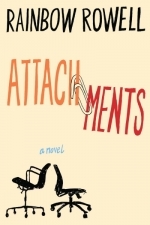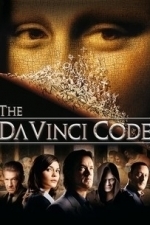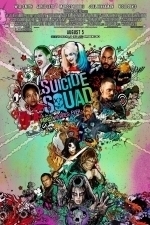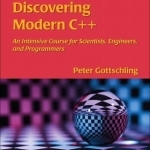
Discovering Modern C++: An Intensive Course for Scientists, Engineers, and Programmers
Book
As scientific and engineering projects grow larger and more complex, it is increasingly likely that...

JKZ Series1
Health & Fitness
App
Dr Jon Kabat-Zinn’s Series 1 – NOW available as an app! The Series 1 mindfulness meditation app...

100 of the World's Tallest Buildings
Council on Tall Buildings and Urban Habitat and Antony Wood
Book
Features the official current list of the "100 Tallest Buildings in the World," as the CTBUH is the...
Kaysee Hood (83 KP) rated Attachments in Books
Nov 16, 2017
1. This is Rainbow Rowell's first published novel, so of course for some it doesn't hold the magic like Eleanor & Park. Keep in mind many first books never hold against later published works, but are still good or why would the author be allowed to continue?
2. Even though it was published in 2011, it is based in 1999/2000 for plot reasons as to why Lincoln would have his job. This may offset some readers who might not realize how different 1999 is to 2017 Internet use wise for jobs.
3. The lack of reading into who and why the characters are as they are. In a way, it is the adult version of Fangirl, expect the roles are flipped a tad bit.
Anyway, I loved Attachments because it stayed true to Rowell's style, yet it felt raw compared to how she writes now. There is the unconventional love story of a man falling in love with a woman through the e-mails he reads as part of his job to ensure people are working and not nonsense while on the job. There's characters of all sorts with real world problems and real life flaws. There are topics covered of overbearing mothers and mothers who are too cruel both because of their own life. There is men who never want to be tied down, yet one does due to advice and the right woman. The book covers pieces life without taking from the plot whatsoever.
Lincoln O'Neil is a 28-year-old who could have been a successful man with a normal day shift job if a break up had not left him shattered nine years before. Maybe also if his mother had not coddled him, even though she clearly meant well as it is clear him and his sister, Eve, might have been her whole life. Yet we would not have the awkward, shy man working a the swing shift in the IT office as a "security officer" fixing computers in his spare time when he isn't reading through e-mails that come up flagged in the Webfence program. Apparently the security part was ensuring no one at the newspaper office was using the Internet to look at porn, gamble, or idle chit chat instead of working. Not quite was Lincoln had pictured and he doesn't enjoy reading people's exchanges, but the money is good and will grant him the chance to move out his mom's sooner rather than later.
His mundane routine and nothingness during his shift is filled with some enjoyment as Lincoln reads the e-mails flagged from Beth Fremont and Jennifer Scribner-Snyder. There is nothing harmful. Innocent discussions of water cooler talk, life, relationships, and gossip. As much as he knows it is wrong to continue to read their messages about their lives without flagging them as he would anyone else Lincoln cannot help but to get a kick out of the e-mails.
However it soon becomes apparent Lincoln has fallen for Beth despite the fact he has no idea what she looks like or who is she outside of work. Not to mention she has a boyfriend, Chris, who even though she may rant about to Jennifer, she obviously has not intent on breaking ties with. Not for someone like Lincoln anyway. So he spends his time in turmoil trying to decide if a new job is in order, going back to college, or finding a woman to focus his attention on (which are the very things he tries to do). He even tries to ignore the e-mails, yet can't. He cannot help, but feel for Jennifer's worry over having a baby even though her husband wants one. He cannot help, but captivated by their friendship. He cannot help his feelings for Beth for who she is.
It doesn't help Beth has spotted him labeling him as "A Cute Guy" when he never realized she was around. It is like a game of cat and mouse between them then. Beth still unaware he is reading her e-mails. Lincoln unaware of how often she is close to him even when she is going out of her way to find him.
Thus a budding romance is born. But how much of a romance can it be when Beth has Chris and Lincoln can barely look a woman in the eyes?
Gareth von Kallenbach (980 KP) rated The Da Vinci Code (2006) in Movies
Aug 14, 2019
If you are seeing a pattern forming, you would be correct as it seems that few topics can raise ire and wrath more than the topic of religion, especially if the film proposes a viewpoint that differs from the traditional beliefs that are given by the church, bible, and history.
In the film, a monk appears to murder an elderly man who with his last ounces of strength, manages to leave a cryptic riddle on his body. The bizarre nature of the crime prompts French police inspector Fache (Jean Reno) to travel to the Louvre to investigate the crime. A clue at the crime scene causes the police to summer Robert Langdon (Tom Hanks) from a lecture hall where he is signing his latest book on symbols. Since the deceased was supposed to meet Langdon earlier in the day Langdon has fallen under suspicion for the crime.
As he attempts to decipher the message at the crime scene, Langdon encounters a police cryptologists named Sophie (Audrey Tautou), who informs Robert that he is in danger and soon the duo are fleeing from the police after deciphering some hidden clues at the crime scene.
Before either Robert or Audrey knows what is happening, they are being accused of multiple murders and on the run. As the clues begin to mount, the mystery takes an even stranger turn by the discovery of an artifact that when unlocked, should contain a map.
Seeking refuge and help, the duo arrive at the estate of Sir Leigh Teabing (Sir Ian Mc Kellen), who proceeds to tell Robert and Sophie that the clues they have uncovered are part of a cover-up that segments of the church will stop at nothing to keep secret. The nature of this secret is such that should it become public knowledge, then they very foundations of history, faith, and the church could be shaken to their core.
As the mystery becomes clearer, the group are attacked by a Monk named Silas (Paul Bettany), who has been doing the violent work of someone know as The Teacher in an effort to discover the location of artifacts and those attempting to uncover the mystery.
What follows is a frantic race that travels from Paris to London in an effort to get to the bottom of the mystery and unravel the true nature of the mystery and the secret that people are willing to kill for in order to protect.
While some may find the mystery, the players, and their motivations confusing, the film does grab hold and moves along at a solid pace. Ron Howard once again shows his skill by directing a film that is different from his other works, yet rich in its visuals and complexity. The scenic locales of the film enhance the mystery (For those who have not read the book), as they attempt to decipher the clues along with the characters.
The work from the cast was solid as Hanks gives a very good if restrained performance in his portrayal. Mc Kellen is a very nice blend of elegance and old world charm that lifts up every scene in which he is in.
While there are those who will lambaste the film for the message it provides, I chose to look at it as a film that does what movies should, entertain and make you think. The film is not saying its assertions are hard and cold facts, what it is doing is providing a vehicle for debate.
In college I was told that through debate comes knowledge and growth for a society. This was common in ancient Greek and Roman society where issues of the day would be debated in open forums. It seems that we as a society have become too insistent to take things at face value and have forgotten that the very nature of the human experience is to question, grow, and seek our own answers. As such the film is a great example of how Hollywood at times gets it right and provides solid entertainment that will stimulate as well as entertain.
Mark Jaye (65 KP) rated Suicide Squad (2016) in Movies
May 14, 2019
You know the synopsis I'm guessing (if you're reading this review) - government official Amanda Waller assembles a group of the baddest incarcerated criminals to go up against the potential of a metahuman crisis should the 'next' Superman not share our values. This is deemed more relevant following the demise of the man of steel himself at the climax of Dawn Of Justice. Amongst those villains are Deadshot (Will Smith), Harley Quinn (Margot Robbie), Captain Boomerang (Jai Courtney), El Diablo (Jay Hernandez), and Enchantress/Dr June Moone (Carla Delevigne). Heading up the group is Colonel Rick Flagg (Joel Kinnaman), albeit reluctantly.
The story essentially revolves around Enchantress going rogue and converting a subway station in Midway City into a warzone as she resurrects her brother Incubus and the two attempt to destroy the world. The only criticism I have with the movie concerns the simplicity within which Enchantress 'turns' on the group shortly after it is her actions that cause the senate committee to approve the founding of Task Force X only a couple of scenes earlier in the movie. It just feels a bit rushed. It's also interesting to note that the events of the movie would never have taken place had Waller not established her little 'pet project' to begin with!
The dialogue is witty and sharp and the characters are highly likeable (despite them being arch-villains and - in some cases, murderers). Will Smith is the core of the group as Deadshot and his cold-bloodedness as an assassin is softened by the connection he has to his daughter (how the audience is expected no doubt to warm to him?). Joel Kinnaman's Rick Flagg is also key to the story's heart with his flawed relationship with Dr June Moone - Enchantress's alter ego. Margot Robbie is superb as Harley Quinn although at times it seems as if her rear's the star of the show.
What do I need to say about Jared Leto that hasn't been said before? You'll either love or hate his portrayal of Mr.J!
The Chinese Typewriter: A History
Book
Chinese writing is character based, the one major world script that is neither alphabetic nor...
Darren (1599 KP) rated A Street Cat Named Bob (2016) in Movies
Dec 18, 2019
Story: A Street Cat Named Bob starts as we meet homeless addict James (Treadaway) who spends his days singing for enough money that could get him a meal and a fix, when he overdoes, Val (Froggatt) gives him a chance to get emergency living to clean up with act. James is willing to make this happen and he ends up meeting a stray cat.
Reluctantly James decides to keep Bob the cat and learns to grab a new lease for life and that as a double act they could achieve things he could only dream of as a musician, as well as finding love in one of the neighbours Betty (Gedmintas).
Thoughts on A Street Cat Named Bob
Characters – James is a homeless drug addict who has an overdose. He is given a big chance to go on the path to recovery with an emergency home, where he meets a cat and suddenly he starts to see his life turn around, his busking lifestyle sees him make money, he meets a new woman and can support himself, he will need to go through the toughest test of his life, if he wants to break free of his addictions. Bob is the ginger cat that turns up in James’ life, he won’t leave his side as he helps him clean up his act. Betty is the neighbour that becomes James only human friend, she will show him about vegan life becoming a love interest, even though she has seen how being an addict has taken away somebody in her life before. Val is the person that pushes James into the program, believing he can change and will change, she supports him through the whole process.
Performances – Luke Treadaway in the leading role is brilliant to watch, he shows us just how desperate James is to turn his life around and what he must go through. Ruta Gedmintas and Joanne Froggatt are both great in the supporting roles in the film too.
Story – The story here follows a homeless drug addict that gets his life turnaround thanks to the help of one person and a mysterious ginger cat that gives him happiness. This is based on the real story of the man James and Bob the real cat, we see the recovery process, just how difficult it can be for somebody who is trying to turn their life around. We can see how the ending will come about because there is a book about the turn around, even though it does become entertaining throughout the film.
Biopic/Comedy – The biopic side of this film does show how James does turn his life around, it is shown in a way that could see the struggle he will be facing. The comedy of the film does give you a couple of laughs with how Bob interacts in life.
Settings – The film is set in London which does show how the culture of the homeless people being able to survive around town that is filled with a drug culture that could end their fight.
Scene of the Movie – First day out with Bob.
That Moment That Annoyed Me – Nothing really.
Final Thoughts – This is a delightful little comedy that brings to life one man’s journey to salvation with his new friend Bob the cat.
Overall: Feel Good Movie.

The Handmaid's Tale - Season 1
TV Season Watch
Based on the book by Margaret Atwood of the same name, the series is set in the near future in which...
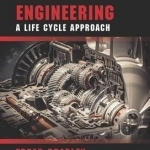
Reliability Engineering: A Life Cycle Approach
Book
Reliability Engineering - A Life Cycle Approach is based on the author's knowledge of systems and...
